The document outlines key concepts in shell scripting, focusing on branching control structures (if-else and case statements) and loop-control structures (for, while, until loops). It also discusses the use of continue and break statements, command substitution, command line arguments, and functions, providing examples for each. Additionally, it includes practice programs to reinforce learning through practical applications.
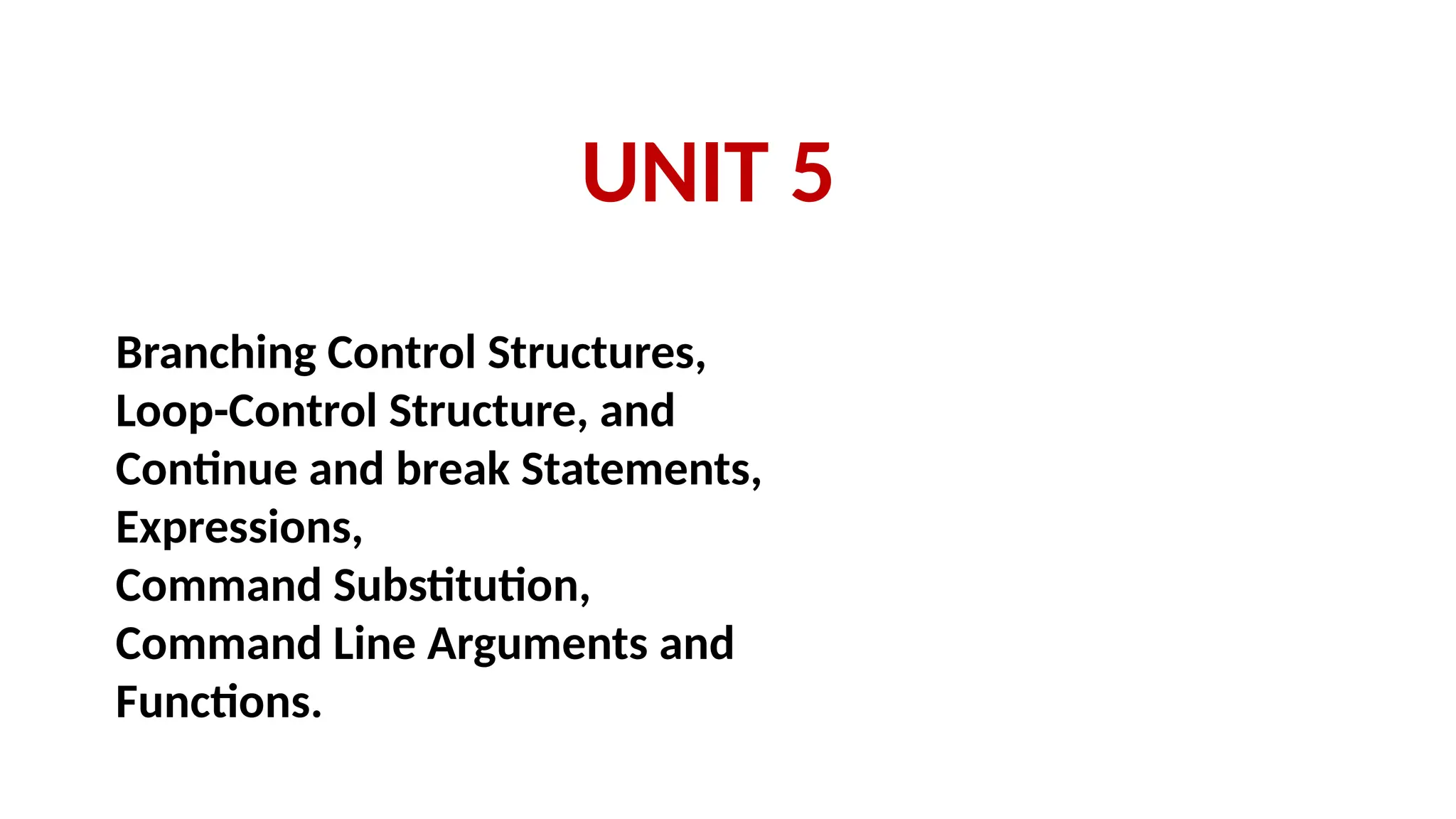
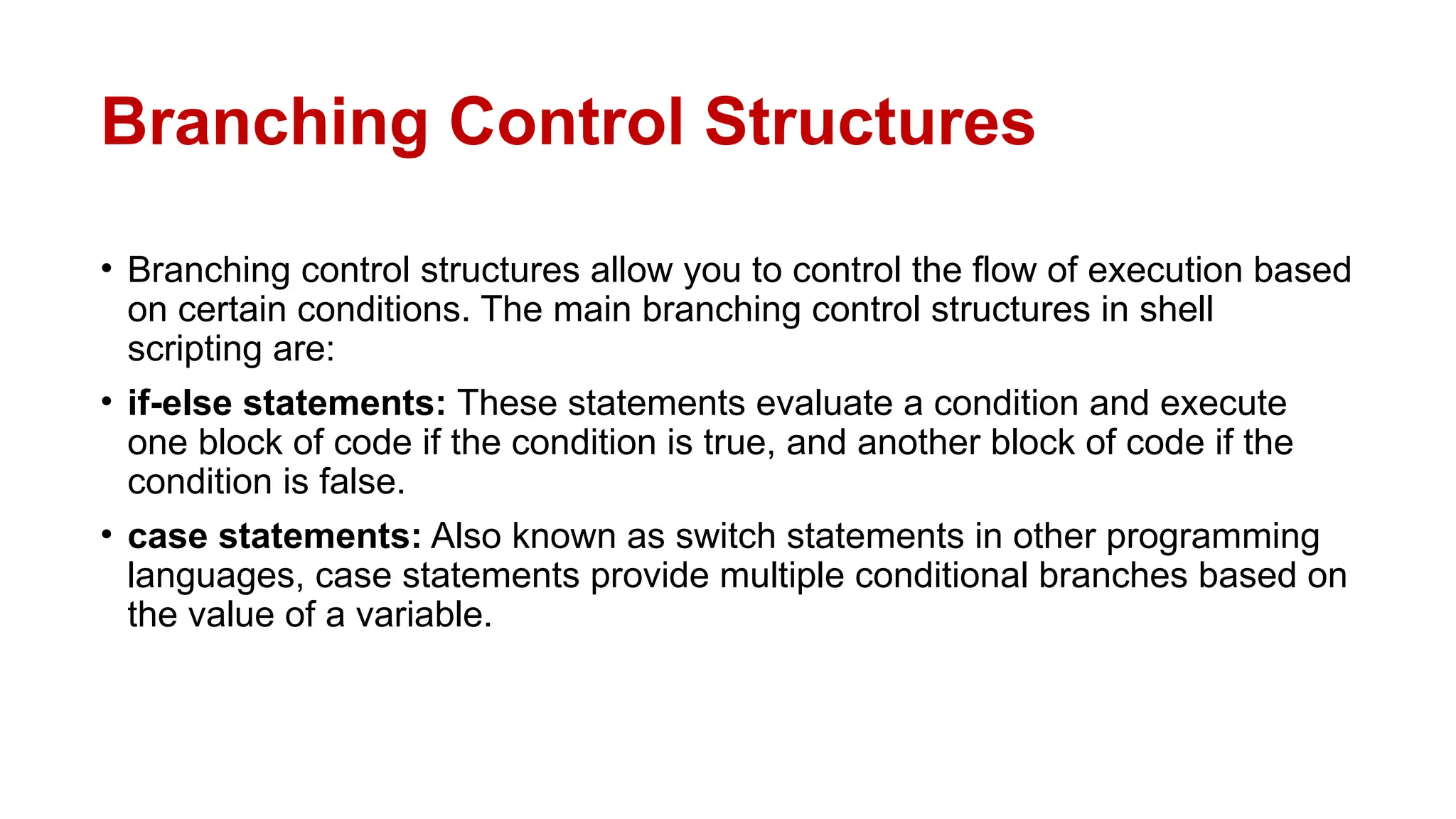
![Examples #!/bin/bash # Example script to check if a number is even or odd echo "Enter a number:" read number if [ $((number % 2)) -eq 0 ]; then echo "$number is even." else echo "$number is odd." fi OUTPUT: Enter a number: 7 7 is odd.](https://image.slidesharecdn.com/unit-5-240925151422-b59db5a1/75/Unix-Shell-Programming-subject-shell-scripting-ppt-3-2048.jpg)

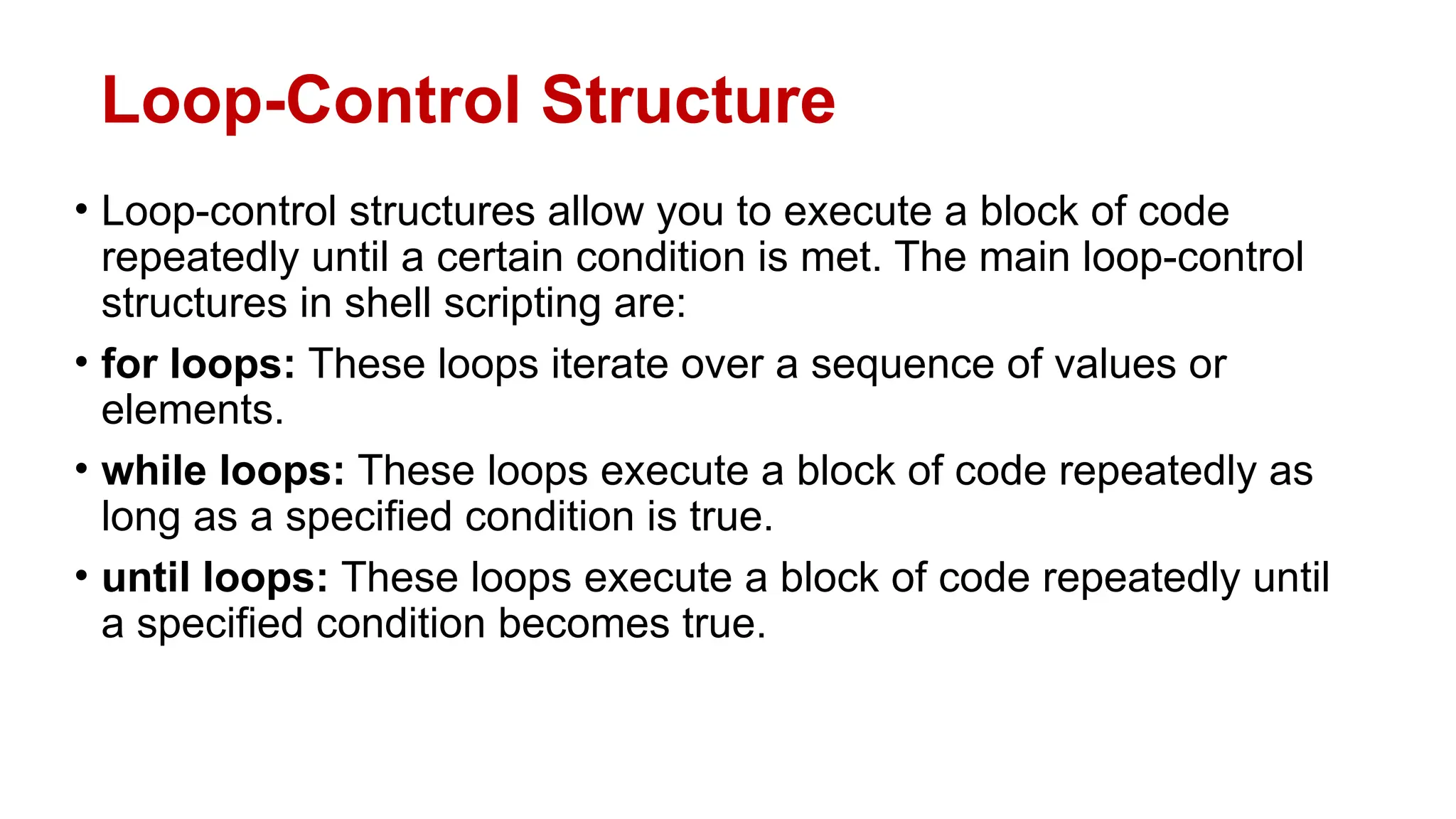
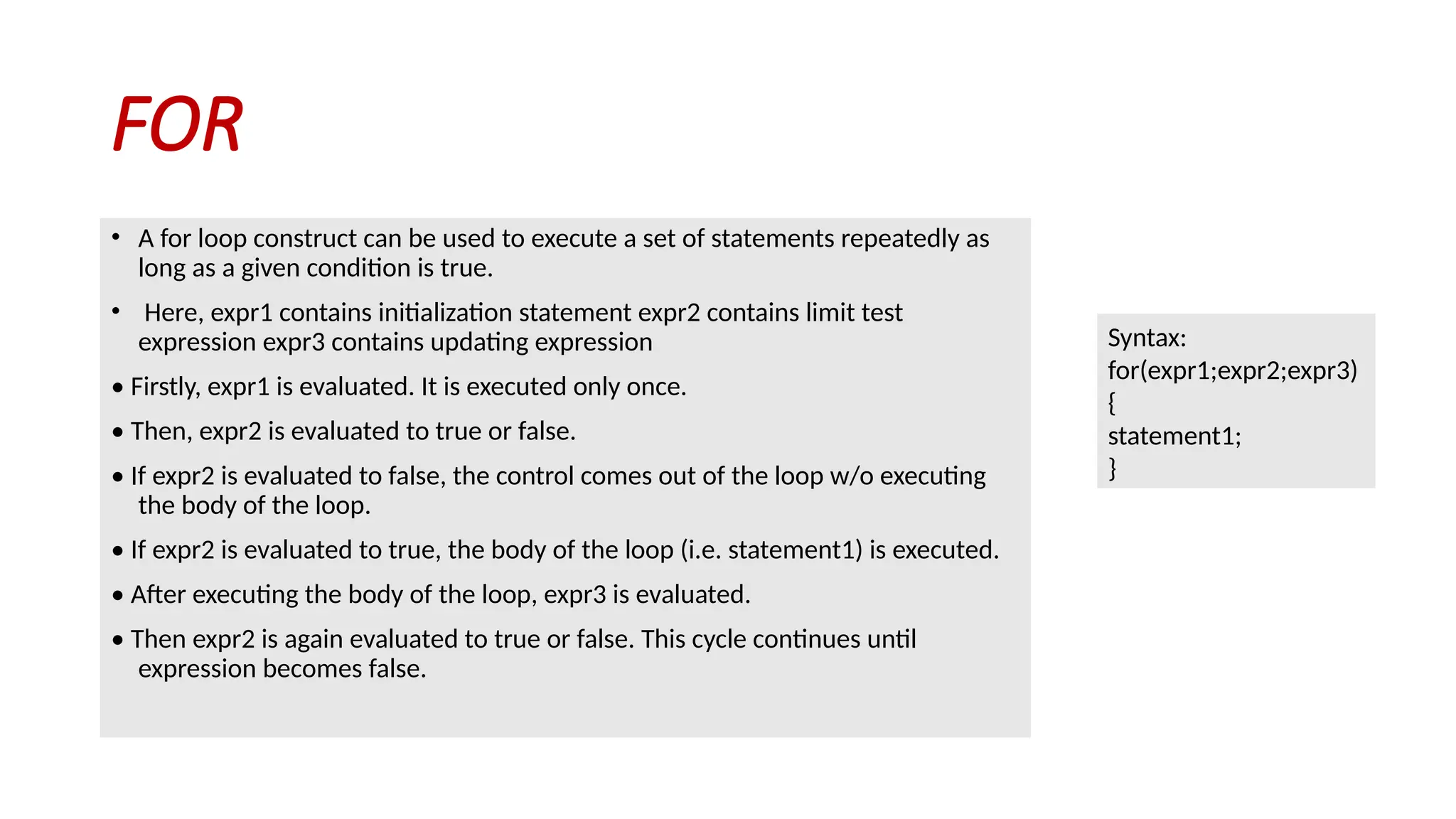

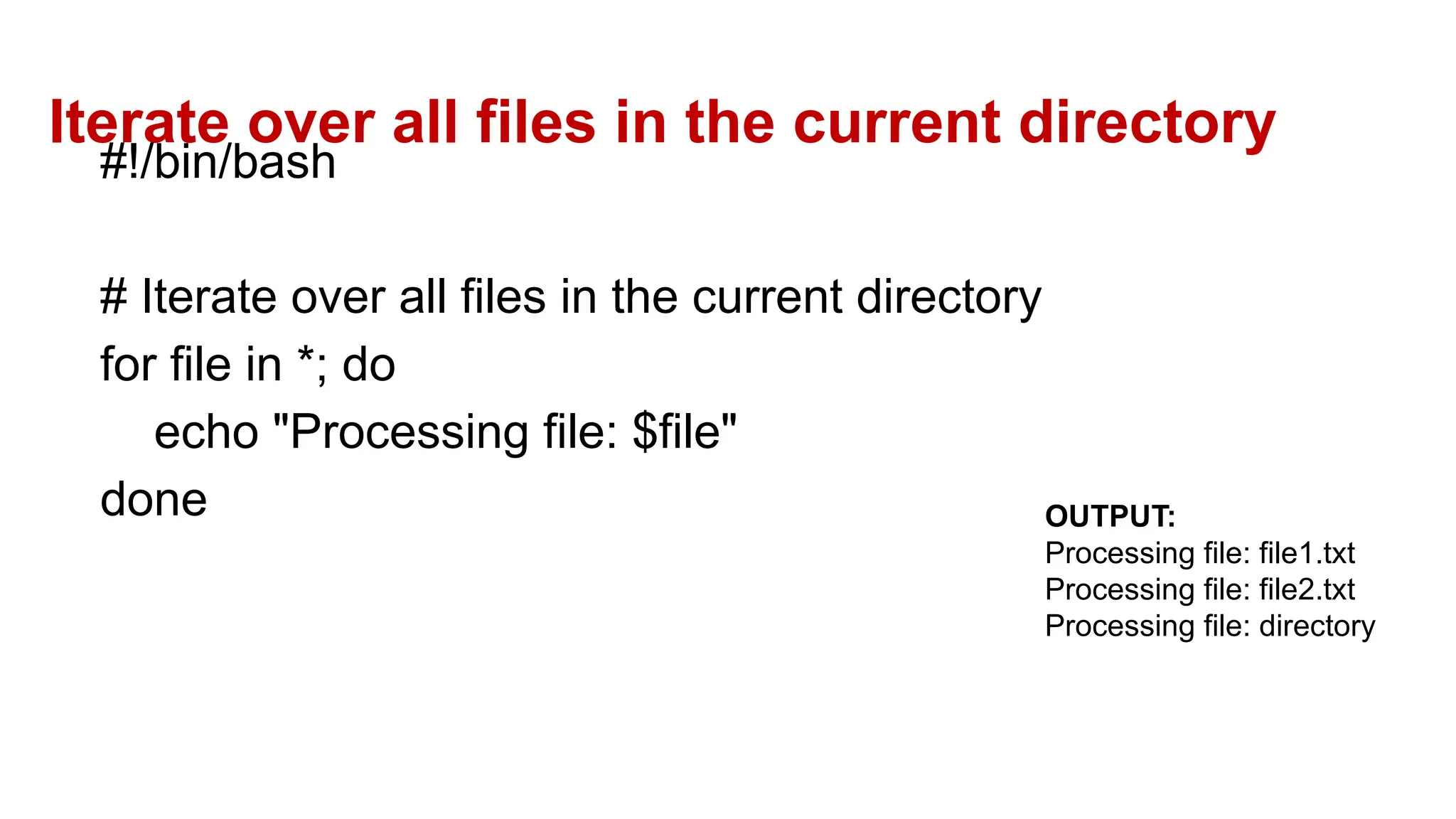
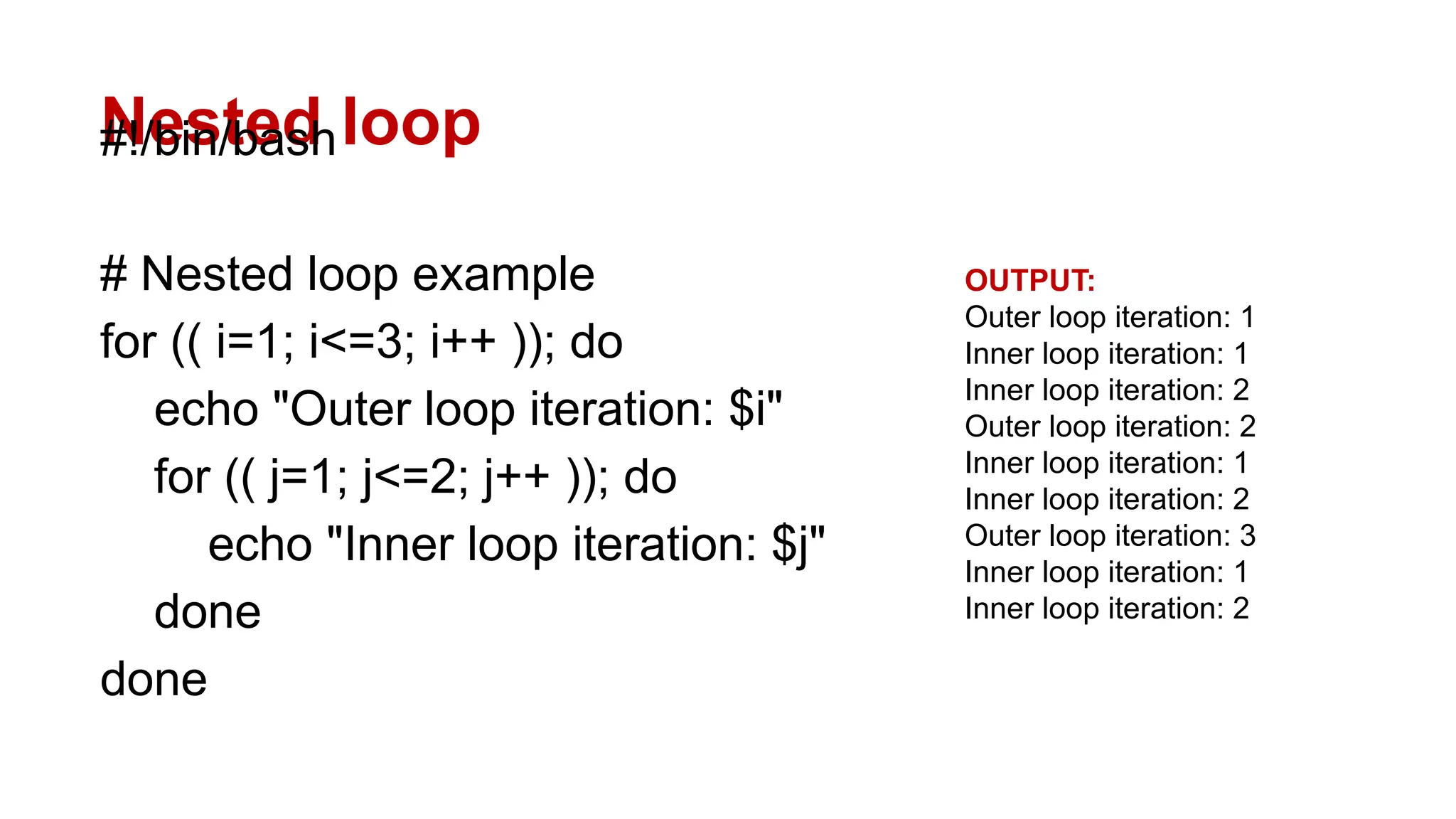

![EXAMPLE } OUTPUT #!/bin/sh a=0 while [$a –lt 10] do echo “$a” a=$(($a+1)) done](https://image.slidesharecdn.com/unit-5-240925151422-b59db5a1/75/Unix-Shell-Programming-subject-shell-scripting-ppt-11-2048.jpg)
![#!/bin/bash # Prompt the user to enter a number echo "Enter a number (0 to exit):" # Initialize the variable to store user input number=1 # Execute the loop until the user enters 0 while [ $number -ne 0 ]; do read -r number echo "You entered: $number" done • echo "Exiting the loop " OUTPUT: Enter a number (0 to exit): 5 You entered: 5 10 You entered: 10 0 You entered: 0 Exiting the loop. Reading user input until a specific condition is met](https://image.slidesharecdn.com/unit-5-240925151422-b59db5a1/75/Unix-Shell-Programming-subject-shell-scripting-ppt-12-2048.jpg)
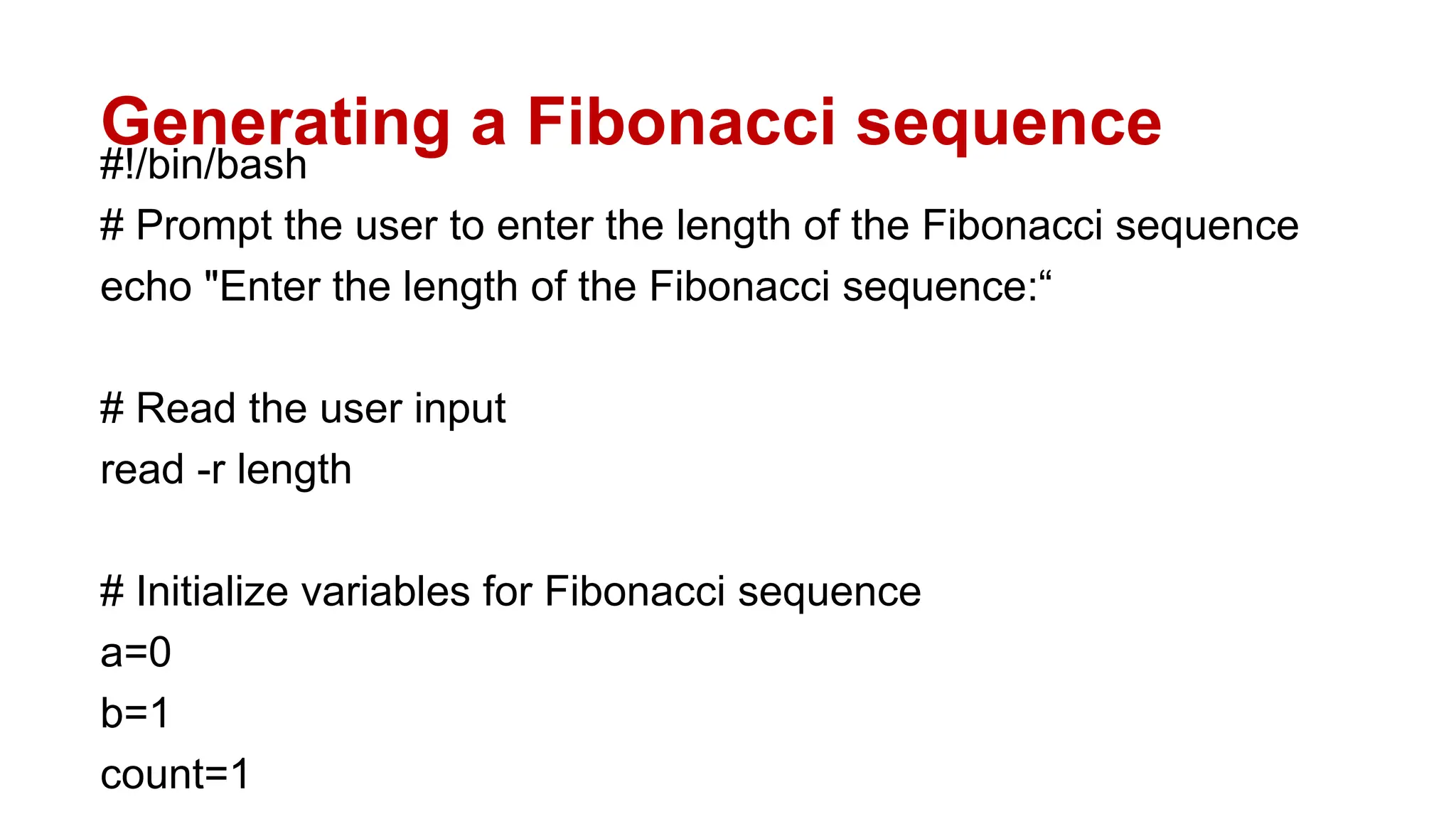
![# Execute the loop to generate the Fibonacci sequence echo "Fibonacci sequence:“ while [ $count -le $length ]; do echo -n "$a " fn=$((a + b)) a=$b b=$fn ((count++)) Done echo "" # Print a newline after the sequence OUTPUT: Enter the length of the Fibonacci sequence: 8 Fibonacci sequence: 0 1 1 2 3 5 8 13](https://image.slidesharecdn.com/unit-5-240925151422-b59db5a1/75/Unix-Shell-Programming-subject-shell-scripting-ppt-14-2048.jpg)
![Until Loop • In an "until" loop, the loop continues executing the code block until the specified condition evaluates to true. • It is essentially the opposite of a "while" loop. • Syntax: until [ condition ]; do # Code to be executed as long as the condition is false done](https://image.slidesharecdn.com/unit-5-240925151422-b59db5a1/75/Unix-Shell-Programming-subject-shell-scripting-ppt-15-2048.jpg)
![UNTIL LOOP #!/bin/bash counter=0 until [ $counter -eq 5 ]; do echo "Counter: $counter" ((counter++)) done echo "Loop finished." OUTPUT: Counter: 0 Counter: 1 Counter: 2 Counter: 3 Counter: 4 Loop finished.](https://image.slidesharecdn.com/unit-5-240925151422-b59db5a1/75/Unix-Shell-Programming-subject-shell-scripting-ppt-16-2048.jpg)
![Squares using Until Loop #!/bin/bash target=10 current=1 until [ $current -ge $target ]; do echo "Current Value: $current" ((current *= 2)) done echo "Loop finished." OUTPUT: Current Value: 1 Current Value: 2 Current Value: 4 Current Value: 8 Loop finished.](https://image.slidesharecdn.com/unit-5-240925151422-b59db5a1/75/Unix-Shell-Programming-subject-shell-scripting-ppt-17-2048.jpg)
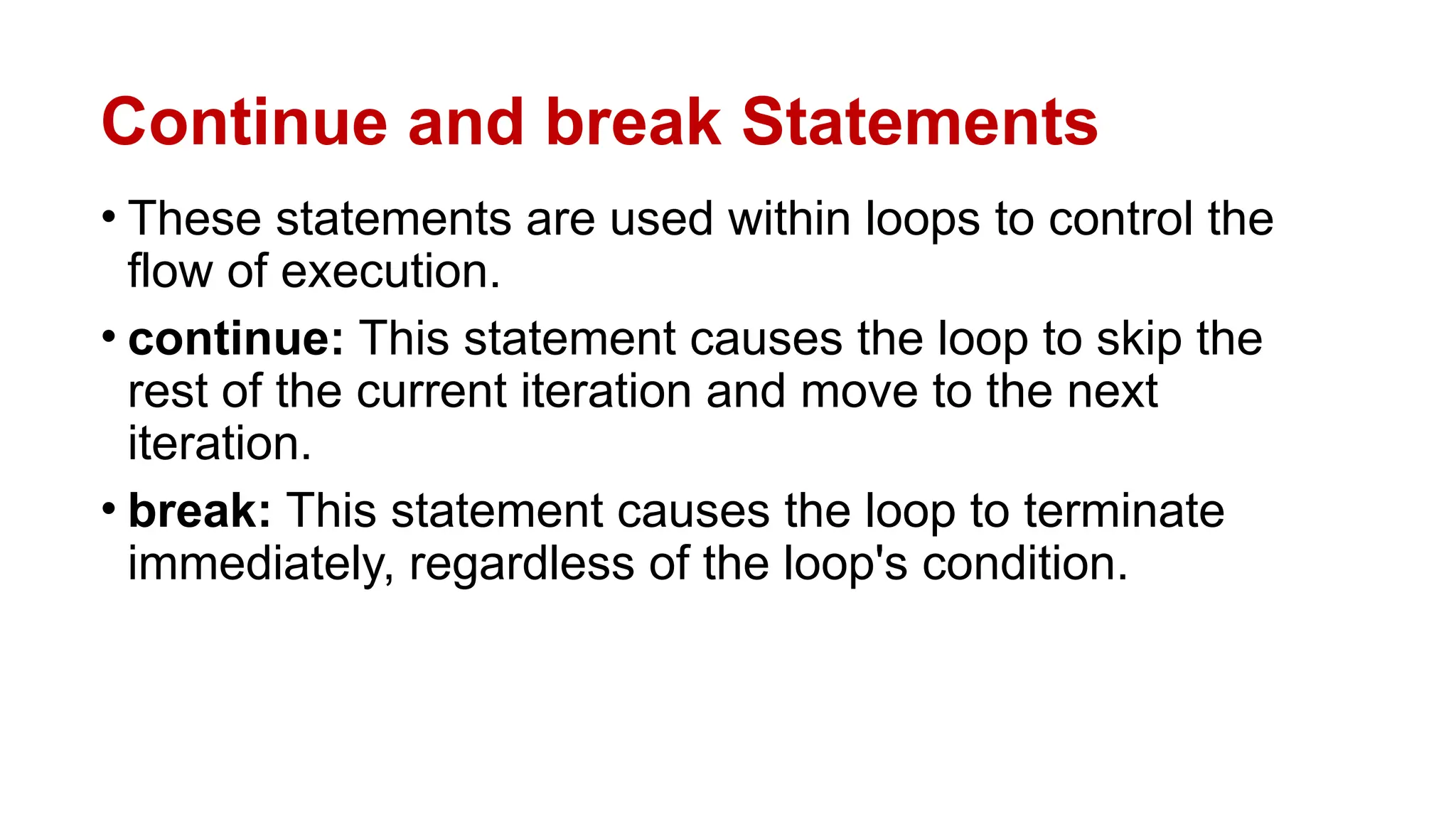
![CONTINUE STATEMENTS • The continue statement is similar to the break command, except that it causes the current iteration of the loop to exit, rather than the entire loop. • This statement is useful when an error has occurred but you want to try to execute the next iteration of the loop. • Syntax: continue [n] //if n is mentioned then it continues from the nth enclosing loop.](https://image.slidesharecdn.com/unit-5-240925151422-b59db5a1/75/Unix-Shell-Programming-subject-shell-scripting-ppt-19-2048.jpg)

![Print even numbers between 1 and 10, skipping odd numbers #!/bin/bash echo "Even numbers between 1 and 10:“ for ((i = 1; i <= 10; i++)); do # Check if the number is odd if [ $((i % 2)) -ne 0 ]; then # Skip to the next iteration if the number is odd continue fi # Print the even number echo "$i" OUTPUT: Even numbers between 1 and 10: 2 4 6 8 10](https://image.slidesharecdn.com/unit-5-240925151422-b59db5a1/75/Unix-Shell-Programming-subject-shell-scripting-ppt-21-2048.jpg)
![BREAK STATEMENT • The break statement is used to terminate the execution of the entire loop, after completing the execution of all of the lines of code up to the break statement. • It then steps down to the code following the end of the loop. • Syntax: break [n] // n is number of nested loops . // By default the value of n is 1.](https://image.slidesharecdn.com/unit-5-240925151422-b59db5a1/75/Unix-Shell-Programming-subject-shell-scripting-ppt-22-2048.jpg)
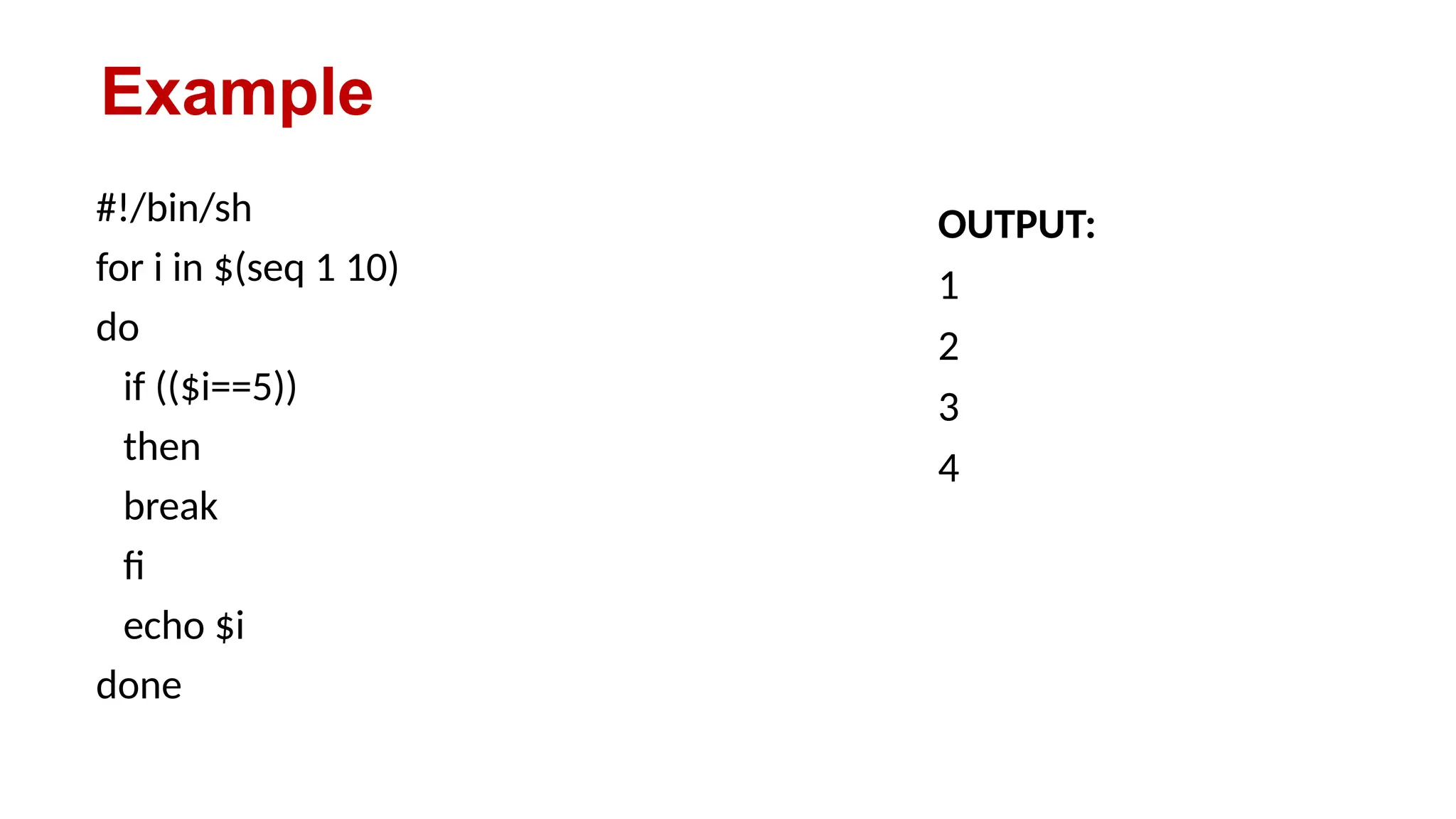
![Find the first negative number in a list of numbers #!/bin/bash echo "Finding the first negative number in the list:" numbers=(5 10 -3 8 -6 2 4) for num in "${numbers[@]}"; do # Check if the number is negative if [ $num -lt 0 ]; then # Print the first negative number and exit the loop echo "The first negative number is: $num" break fi done OUTPUT: Finding the first negative number in the list: The first negative number is: -3](https://image.slidesharecdn.com/unit-5-240925151422-b59db5a1/75/Unix-Shell-Programming-subject-shell-scripting-ppt-24-2048.jpg)
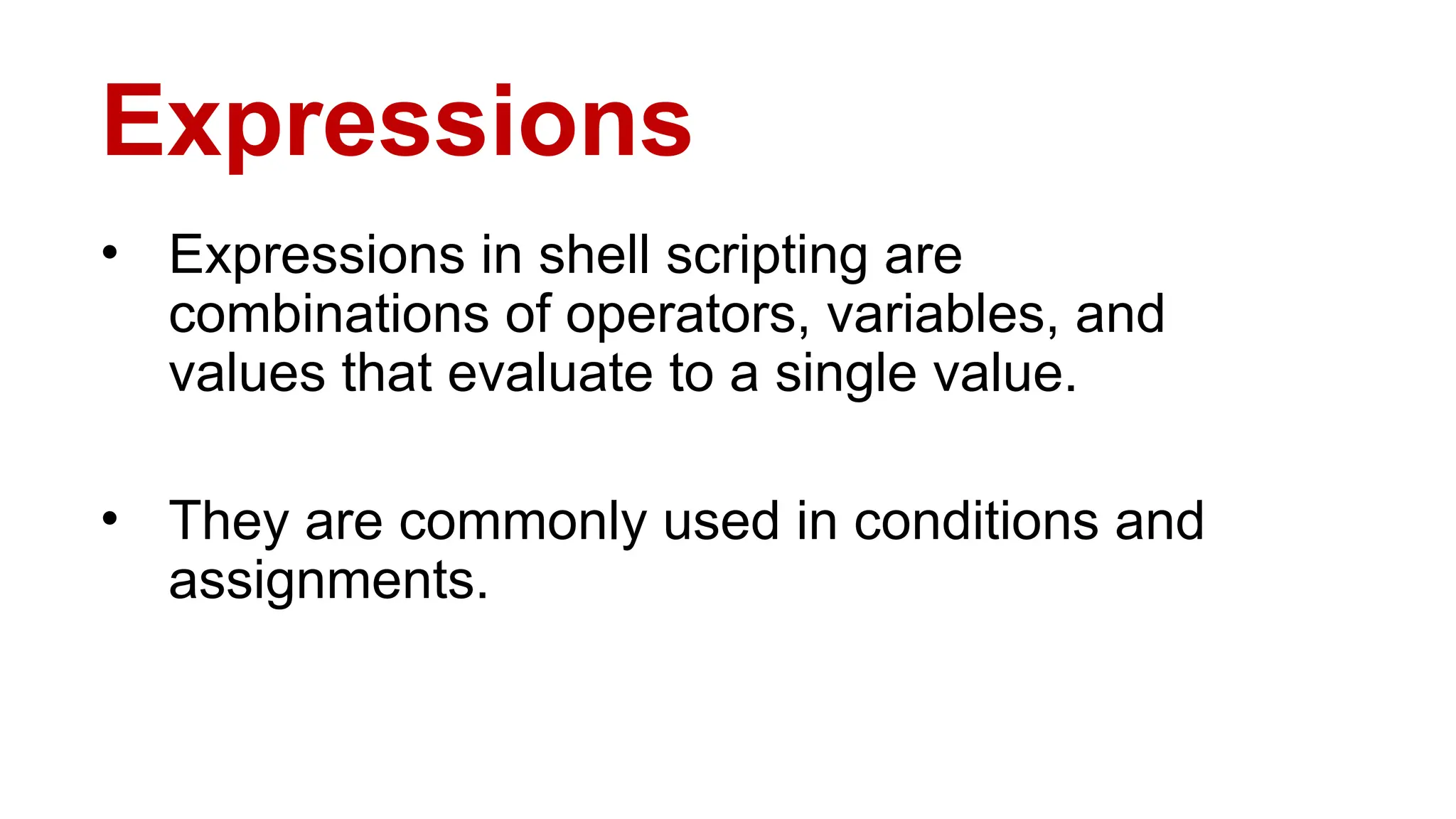


![Comparison Expressions #!/bin/bash value1=10 value2=20 if [ $value1 -eq $value2 ]; then echo "Values are equal" else echo "Values are not equal" fi OUTPUT: Values are not equal](https://image.slidesharecdn.com/unit-5-240925151422-b59db5a1/75/Unix-Shell-Programming-subject-shell-scripting-ppt-28-2048.jpg)
![Logical Expressions #!/bin/bash age=25 if [ $age -ge 18 ] && [ $age -lt 60 ]; then echo "You are an adult" else echo "You are not an adult" fi OUTPUT: You are an adult](https://image.slidesharecdn.com/unit-5-240925151422-b59db5a1/75/Unix-Shell-Programming-subject-shell-scripting-ppt-29-2048.jpg)


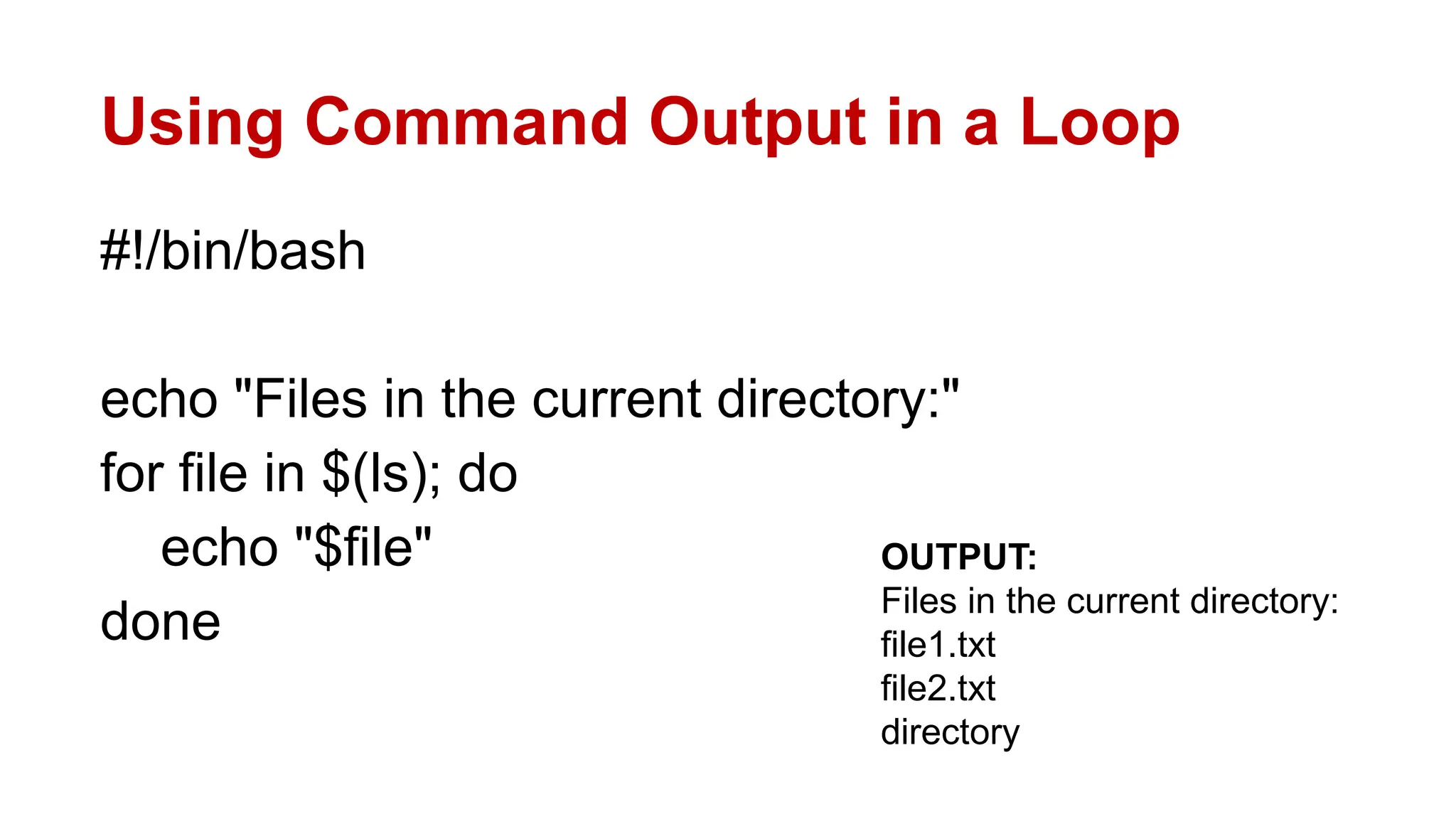
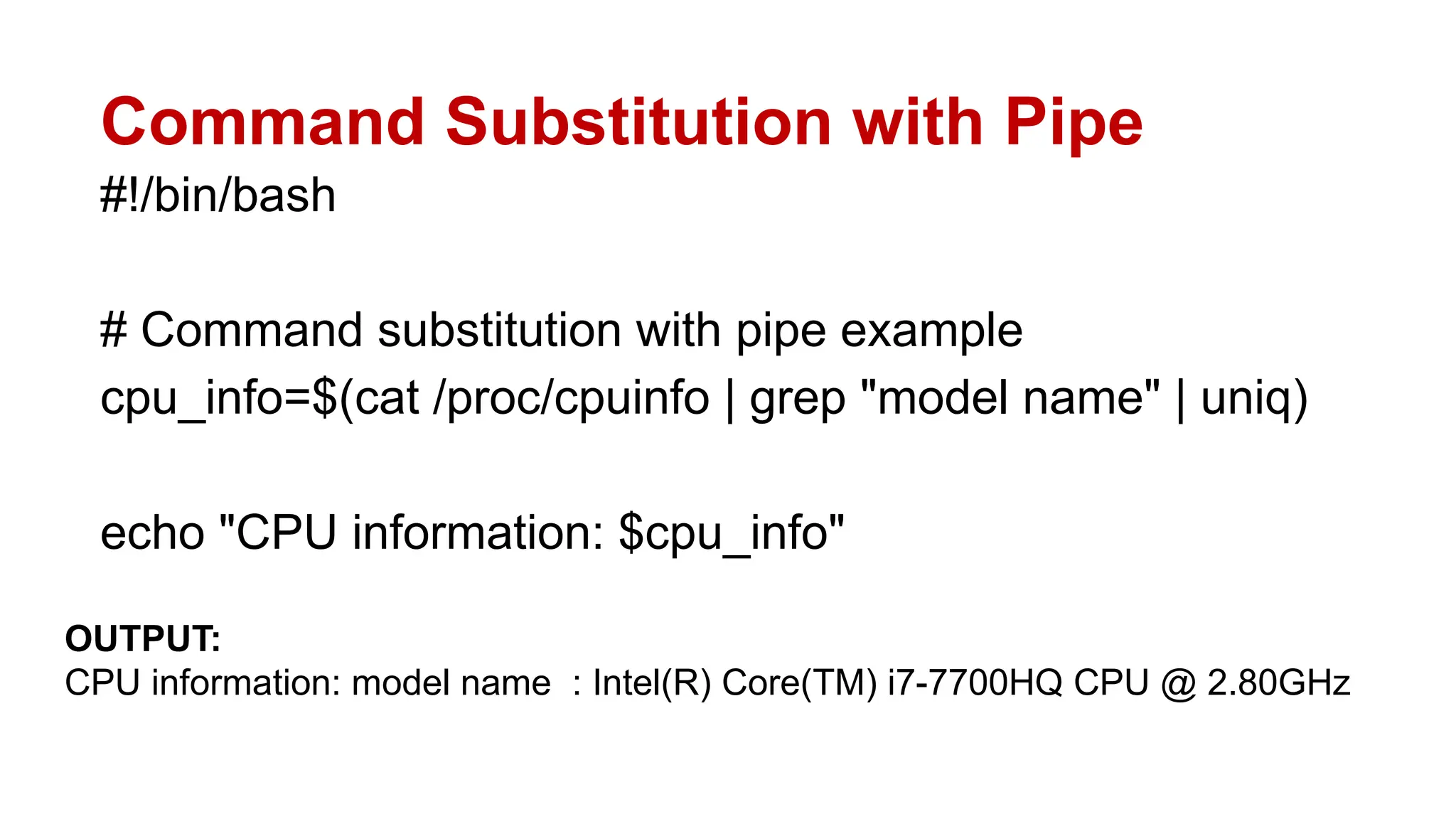
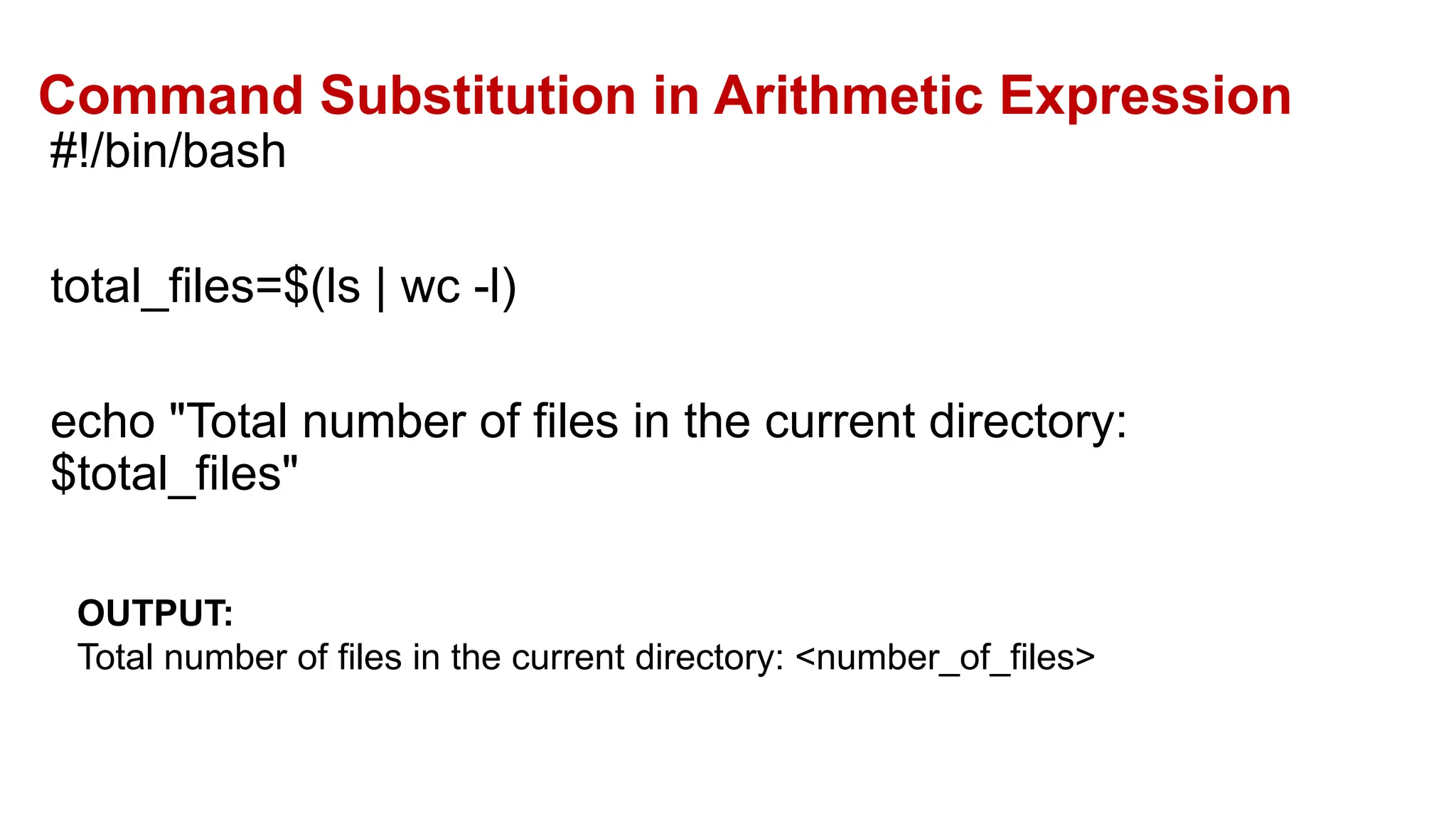
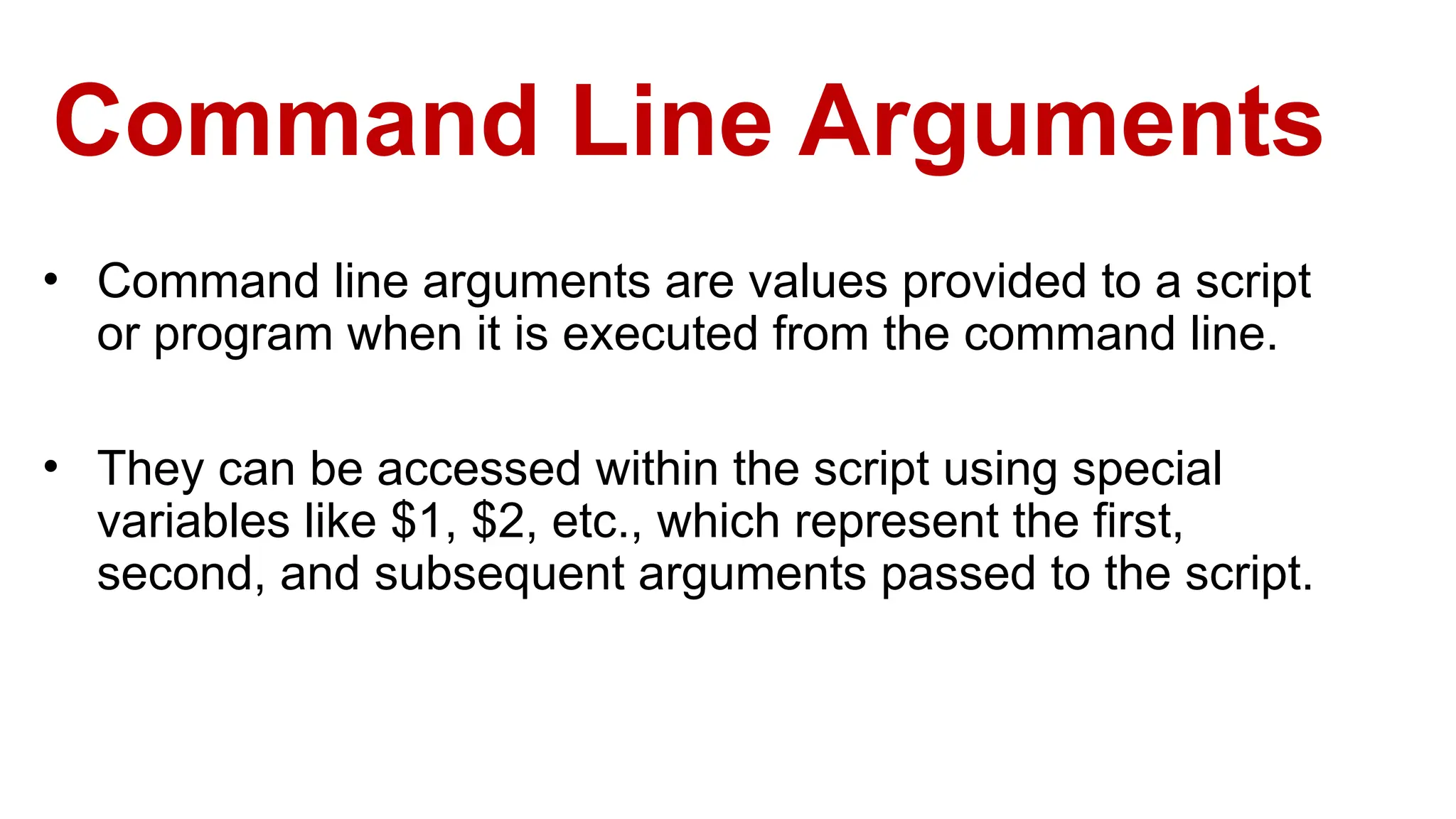
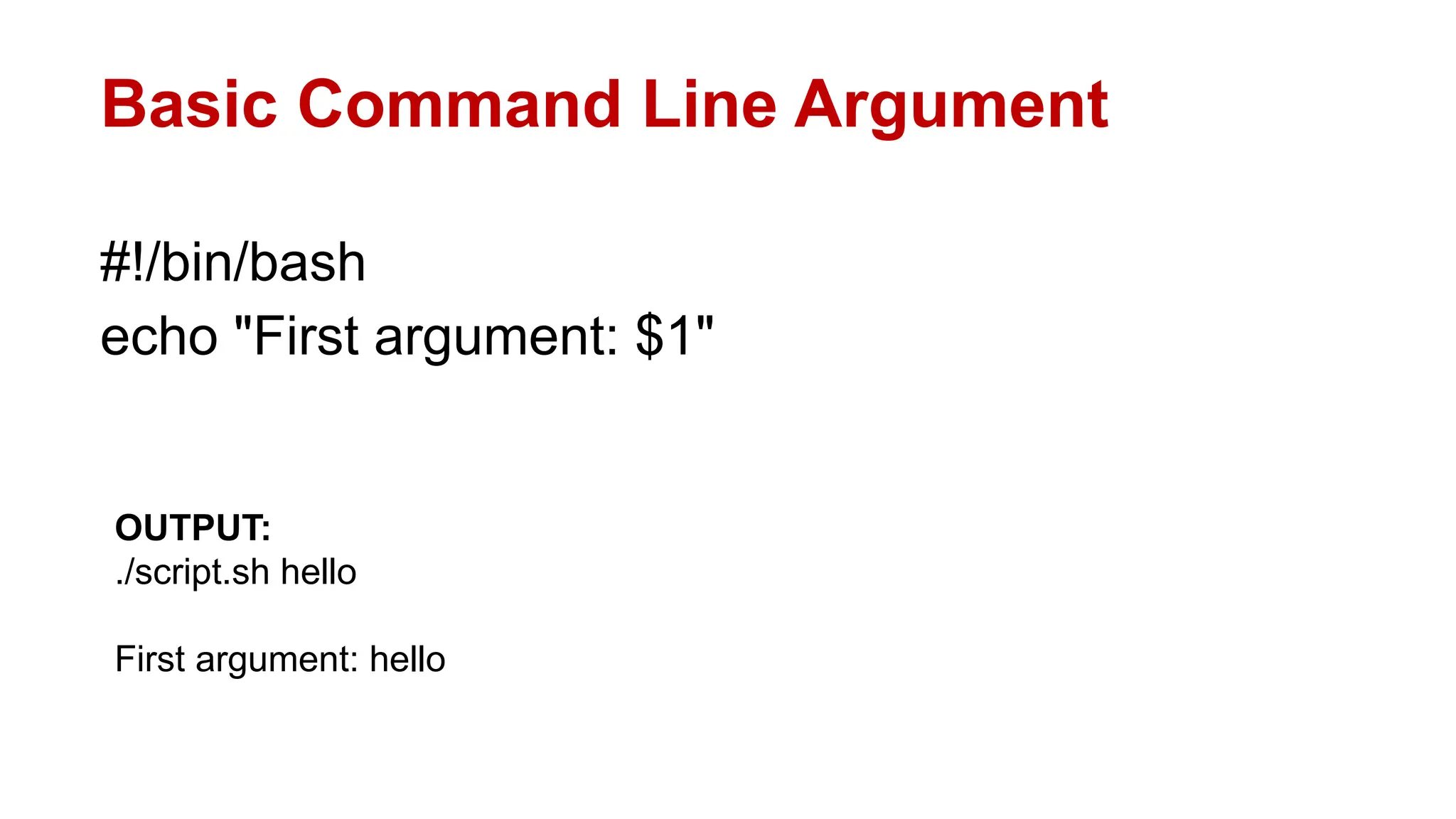
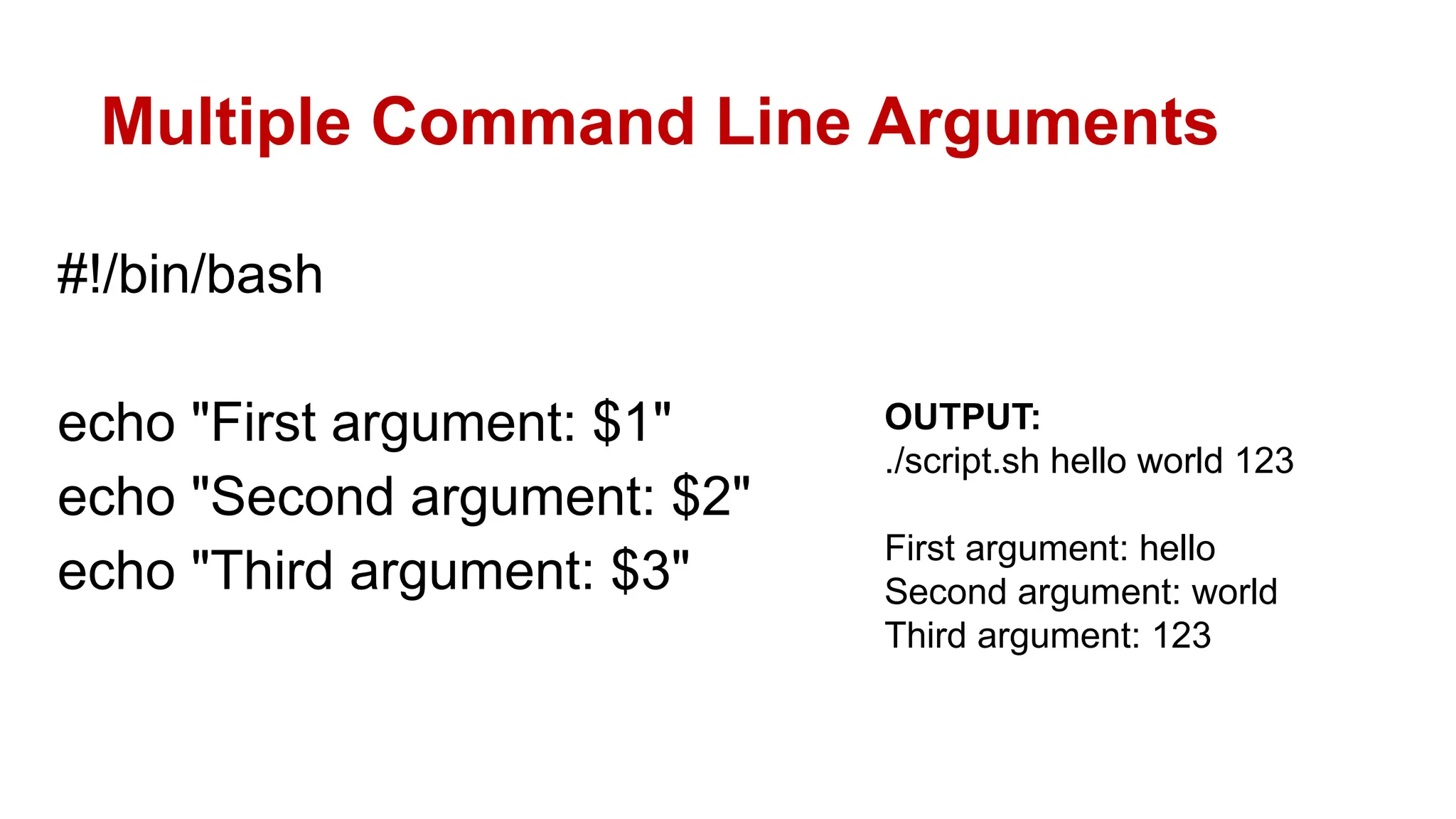
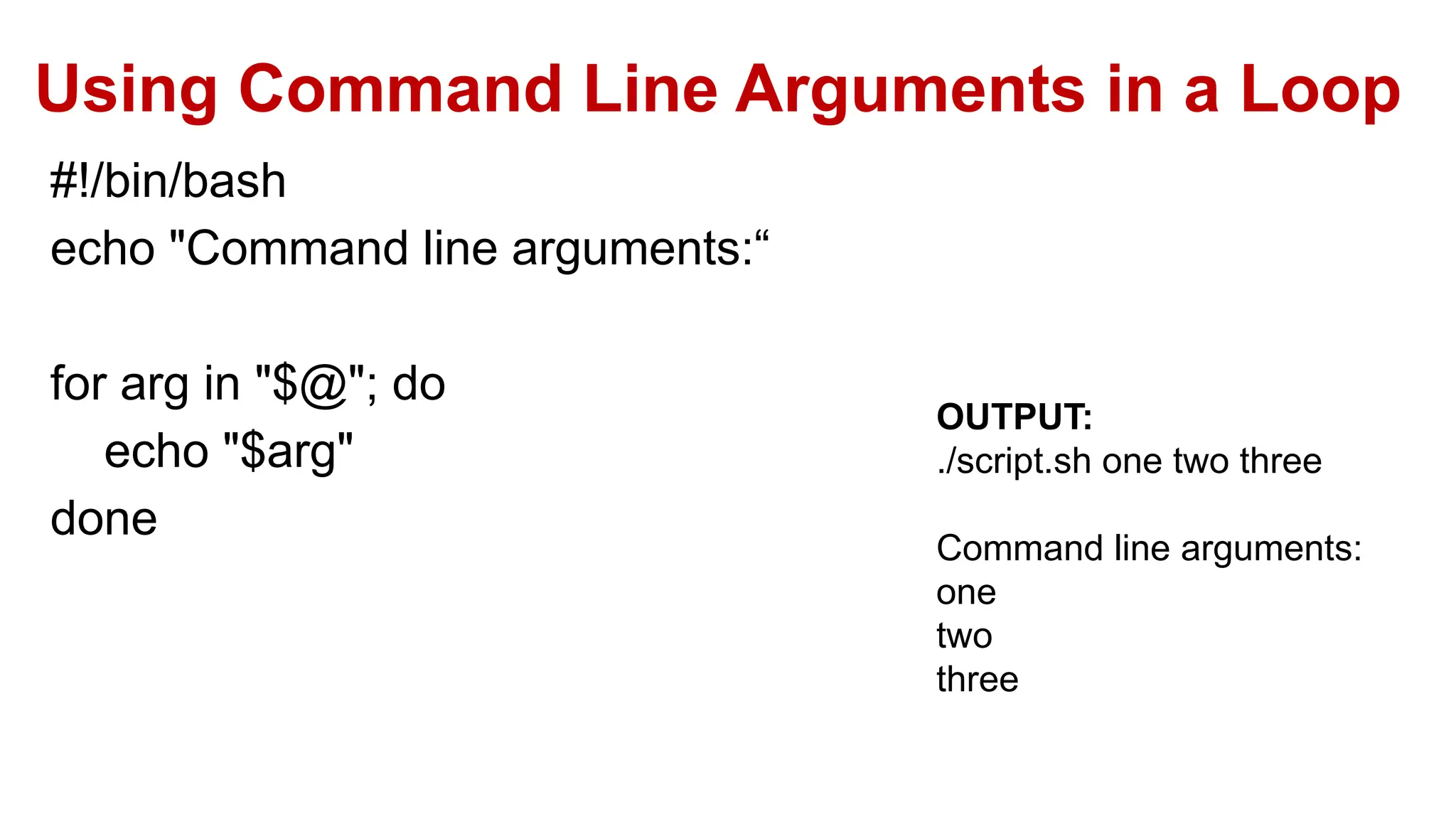



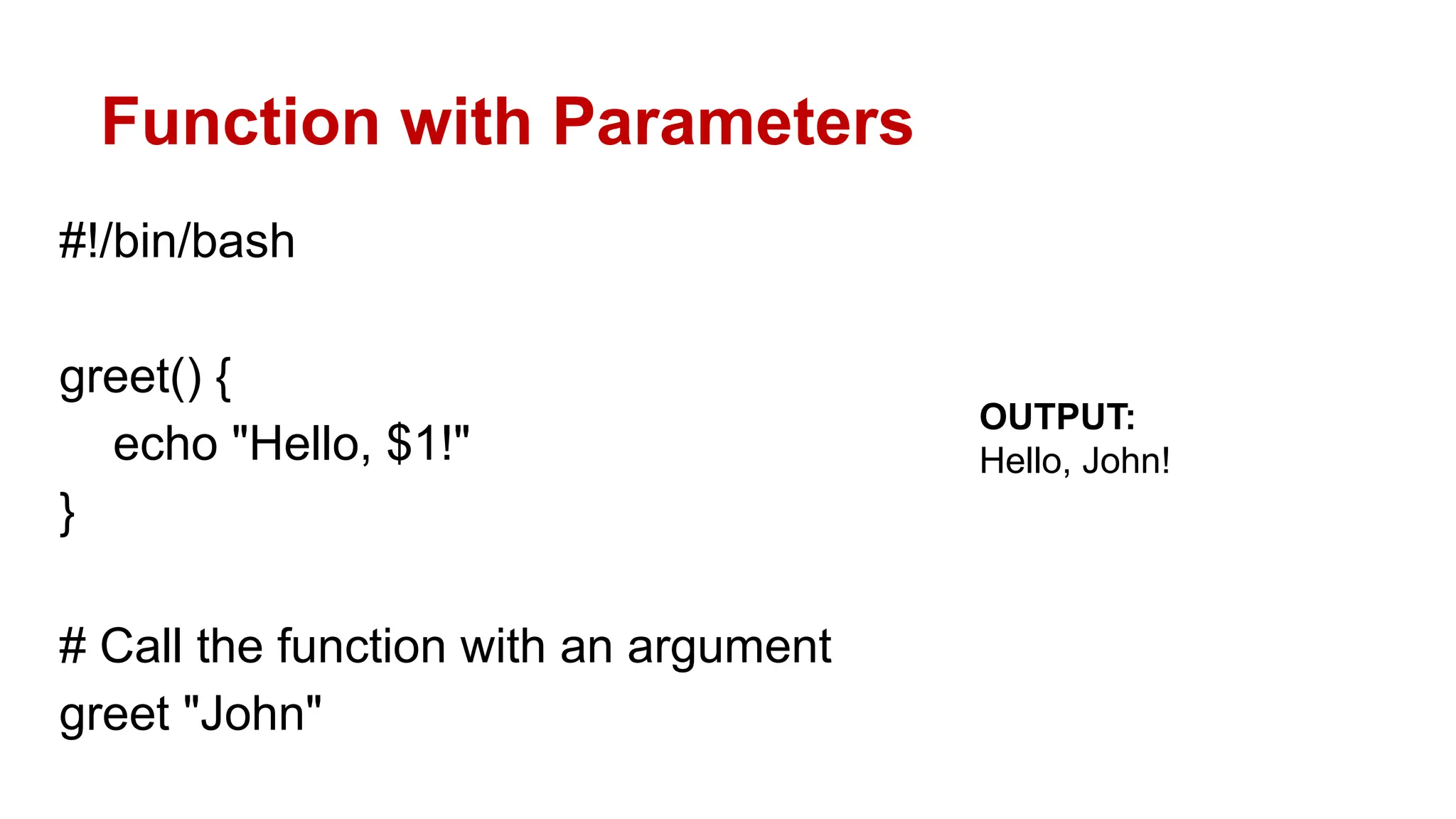
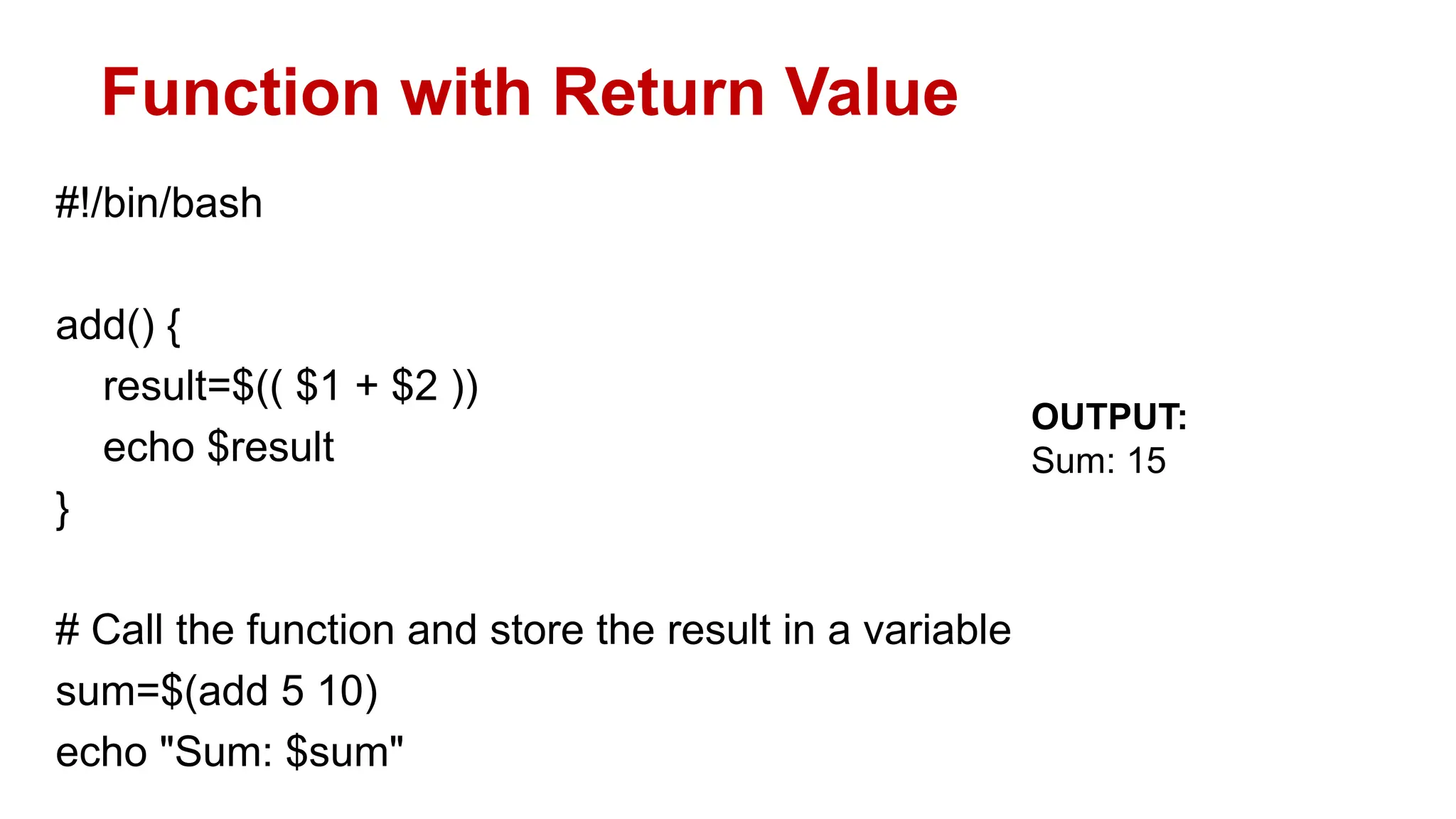
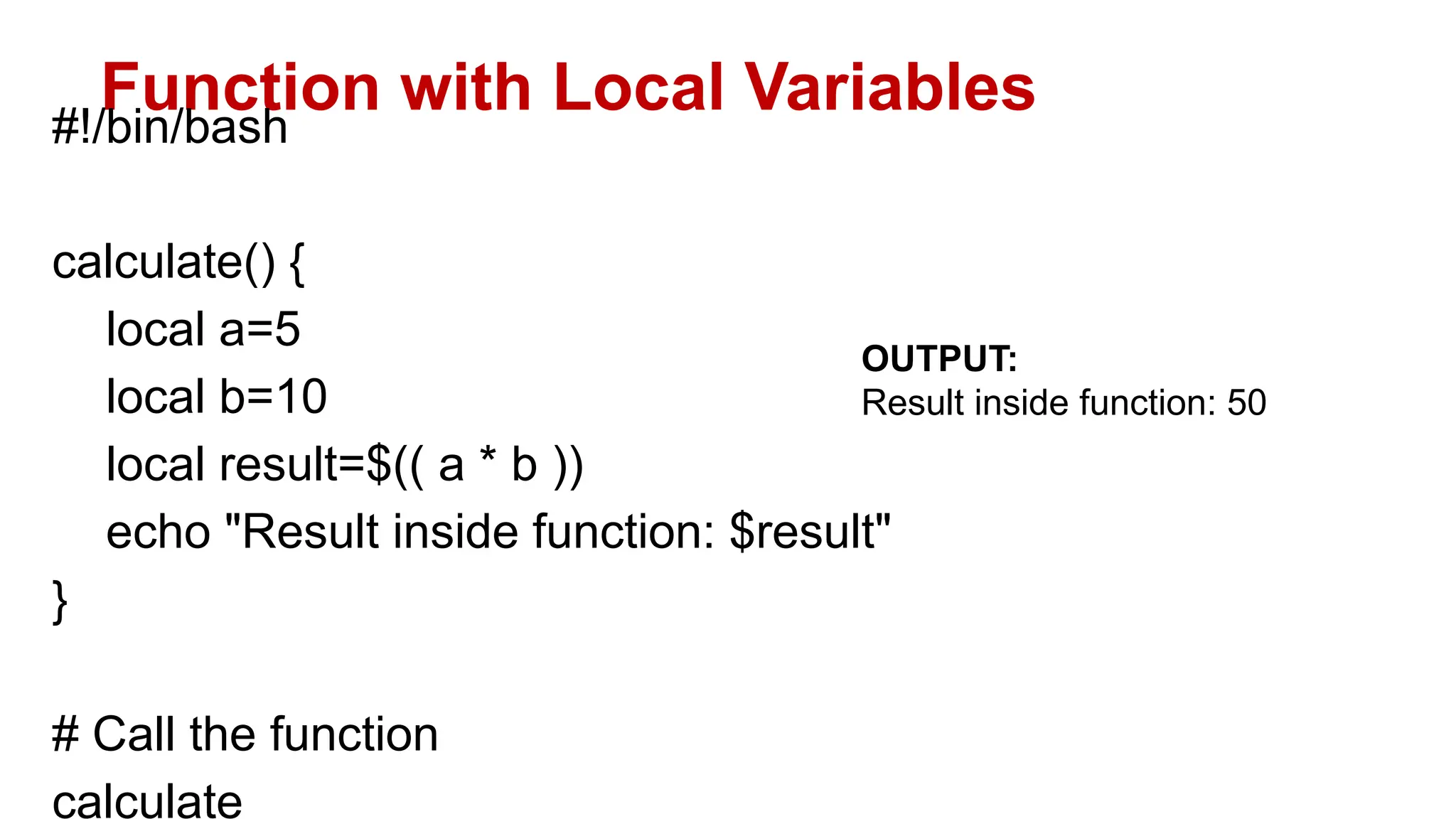
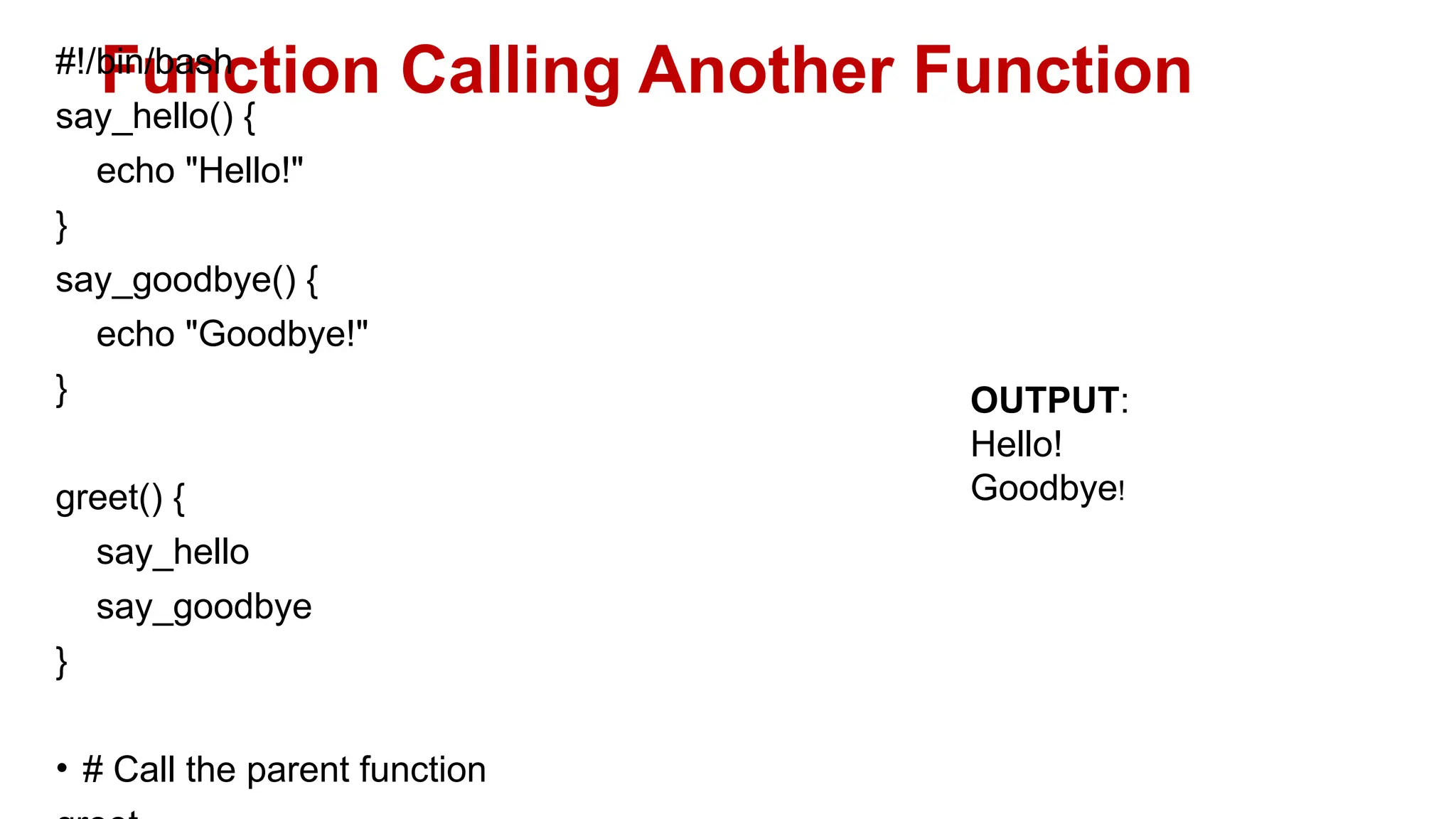
![Recursive Function #!/bin/bash factorial() { if [ $1 -eq 1 ]; then echo 1 else local prev=$(factorial $(( $1 - 1 ))) echo $(( $1 * prev )) fi } # Calculate factorial of 5 result=$(factorial 5) echo "Factorial of 5 is: $result" OUTPUT: Factorial of 5 is: 120](https://image.slidesharecdn.com/unit-5-240925151422-b59db5a1/75/Unix-Shell-Programming-subject-shell-scripting-ppt-46-2048.jpg)
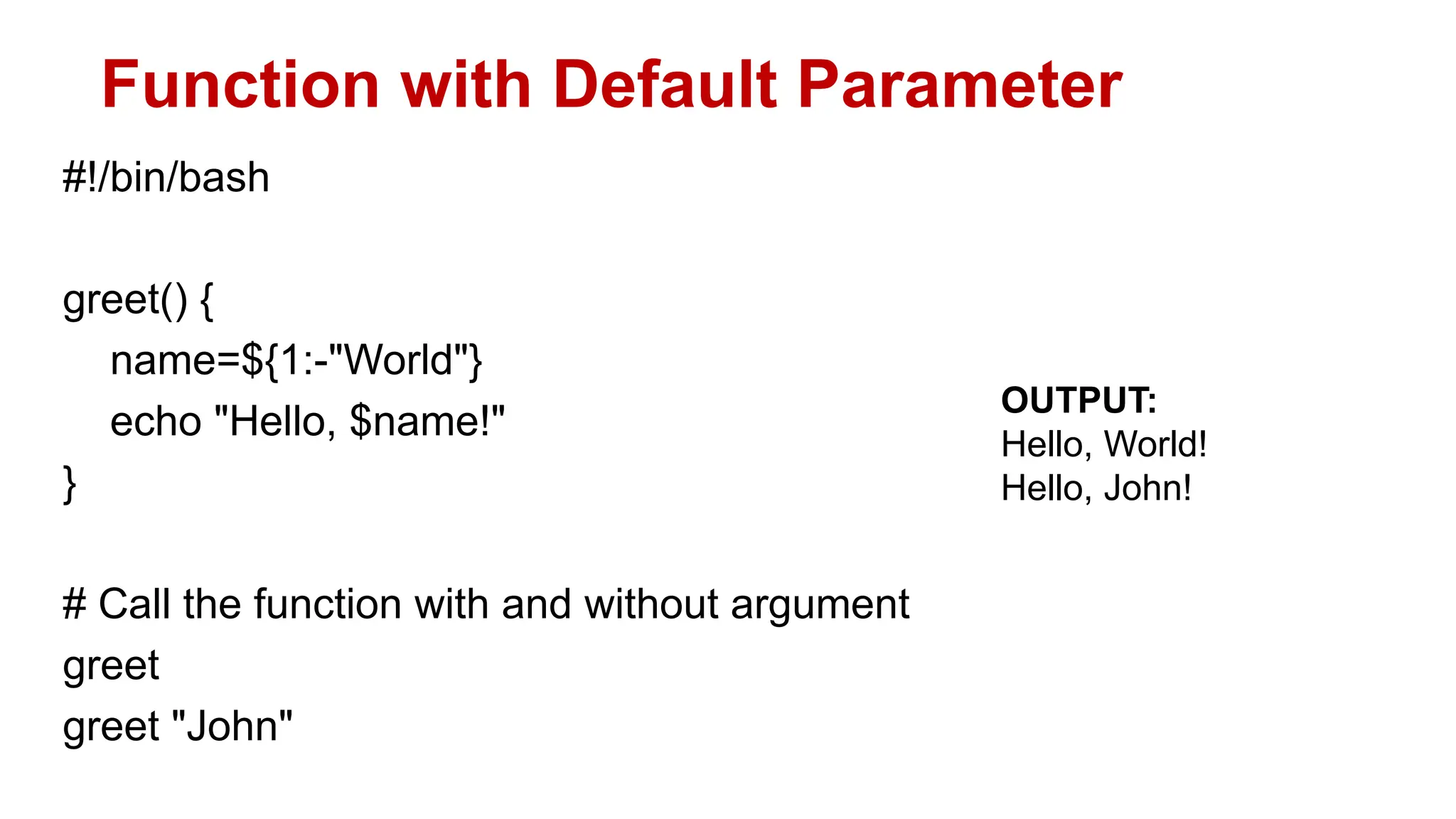
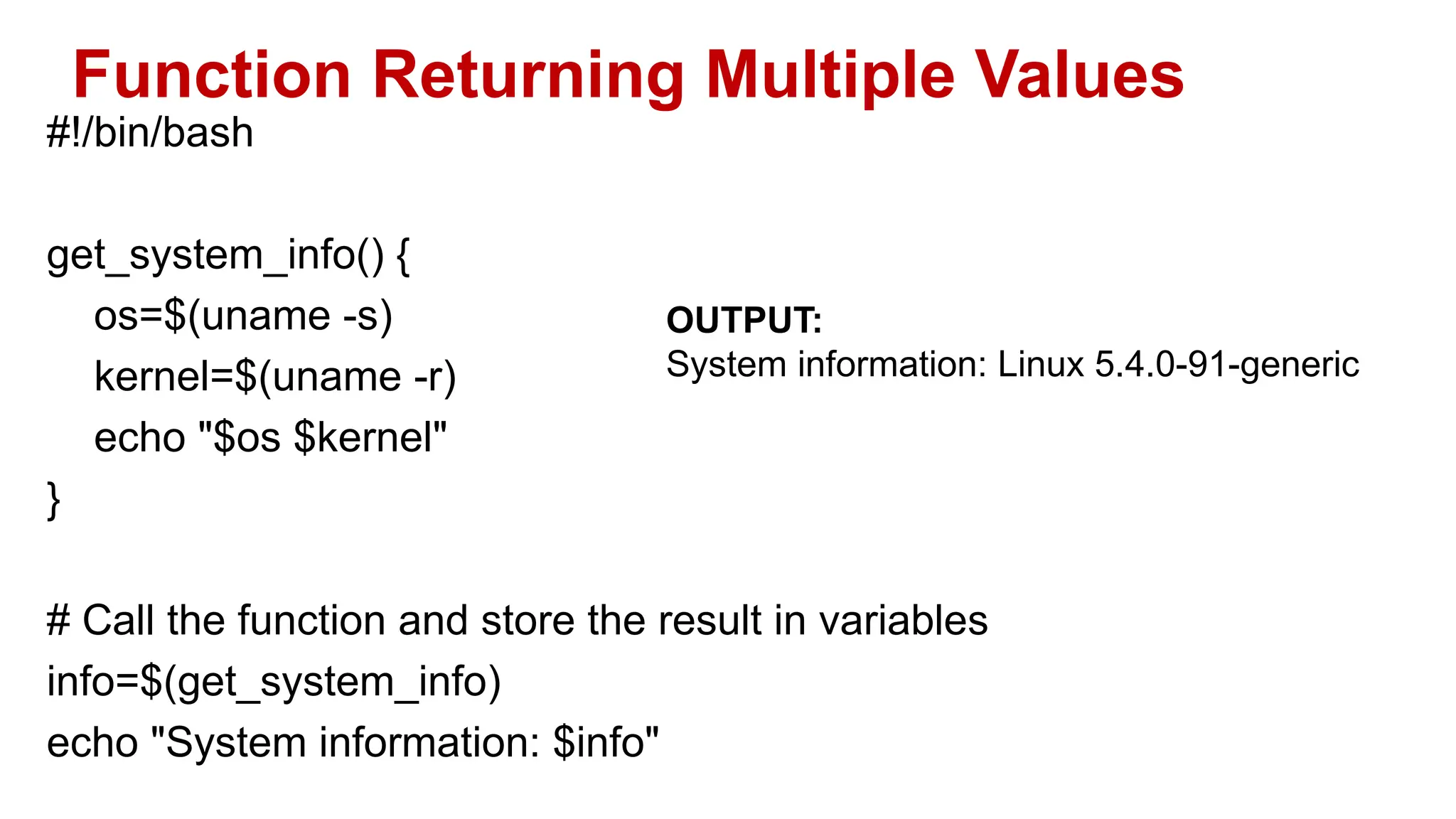
![Function with Error Handling #!/bin/bash divide() { if [ $2 -eq 0 ]; then echo "Error: Division by zero" exit 1 fi result=$(( $1 / $2 )) echo "Result: $result" } # Call the function with different arguments divide 10 2 divide 10 0 OUTPUT: Result: 5 Error: Division by zero](https://image.slidesharecdn.com/unit-5-240925151422-b59db5a1/75/Unix-Shell-Programming-subject-shell-scripting-ppt-49-2048.jpg)

